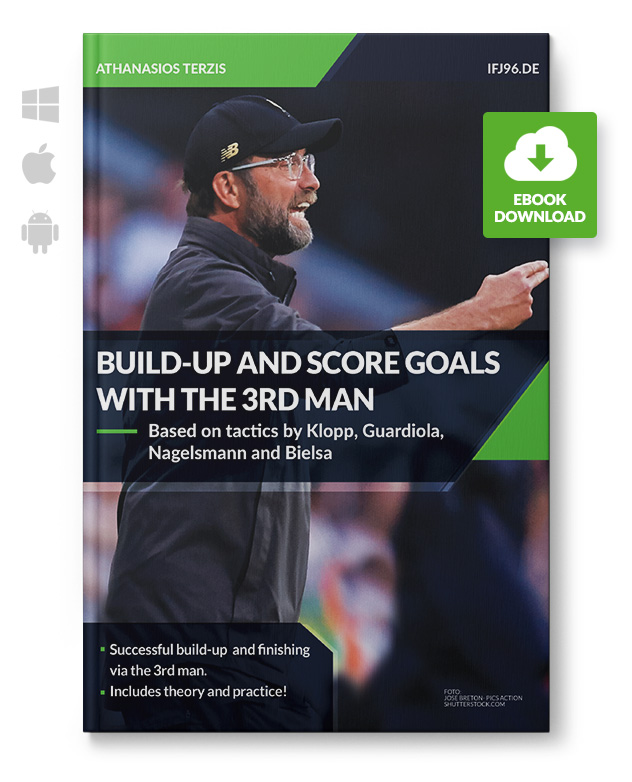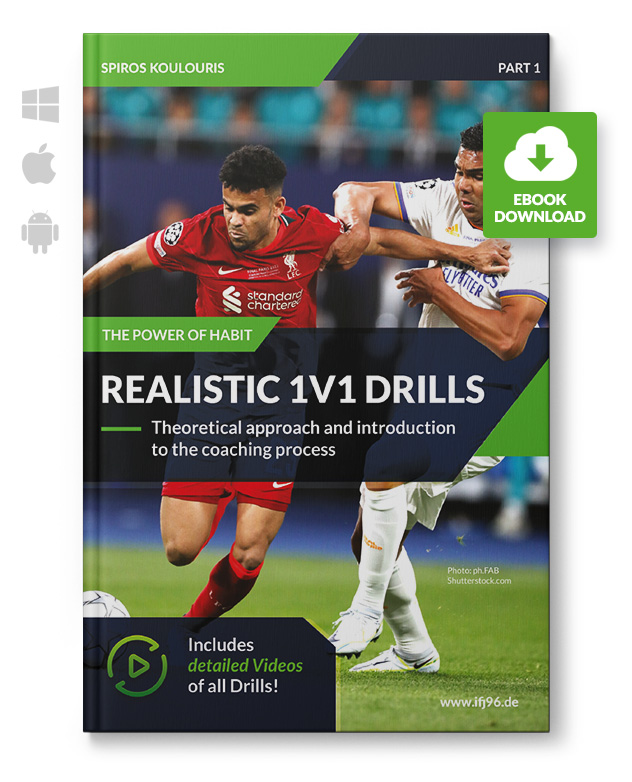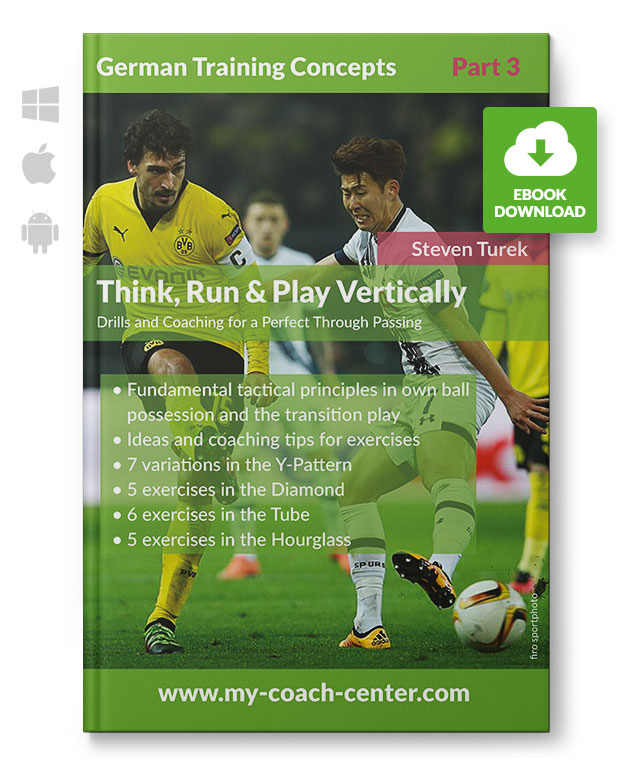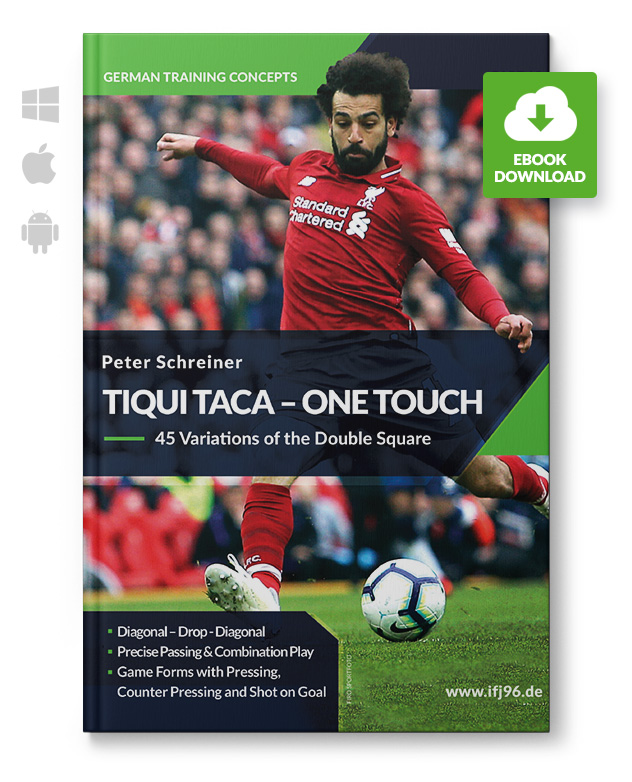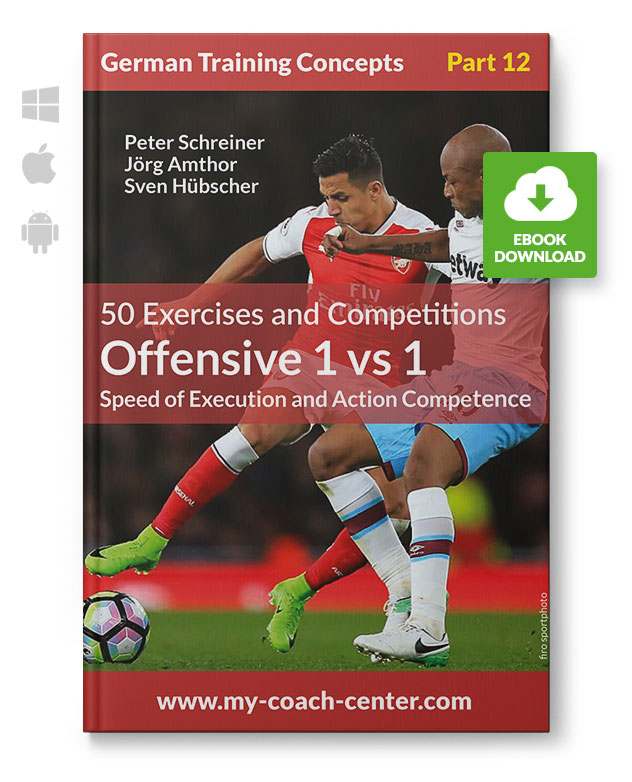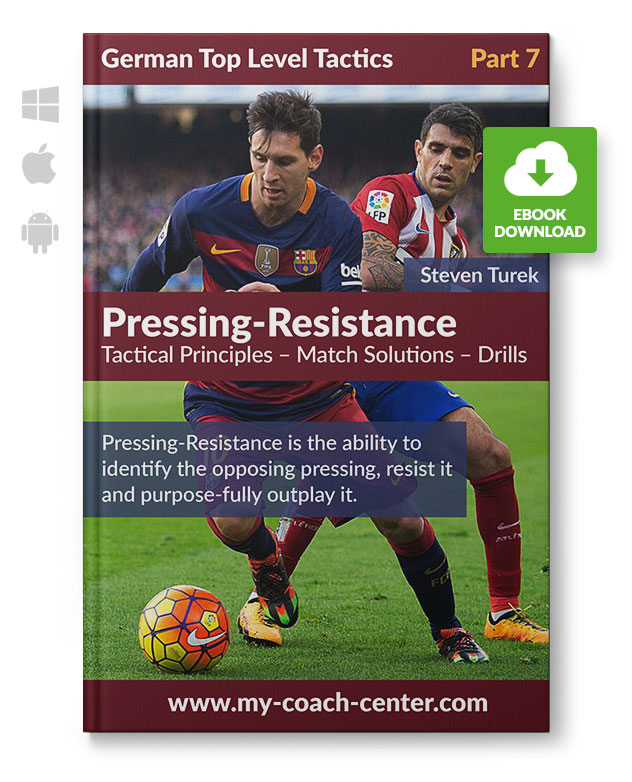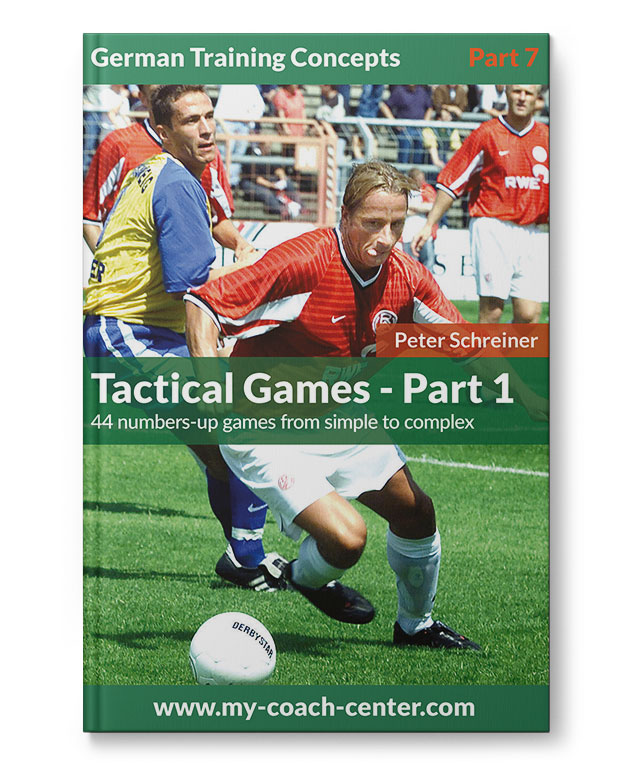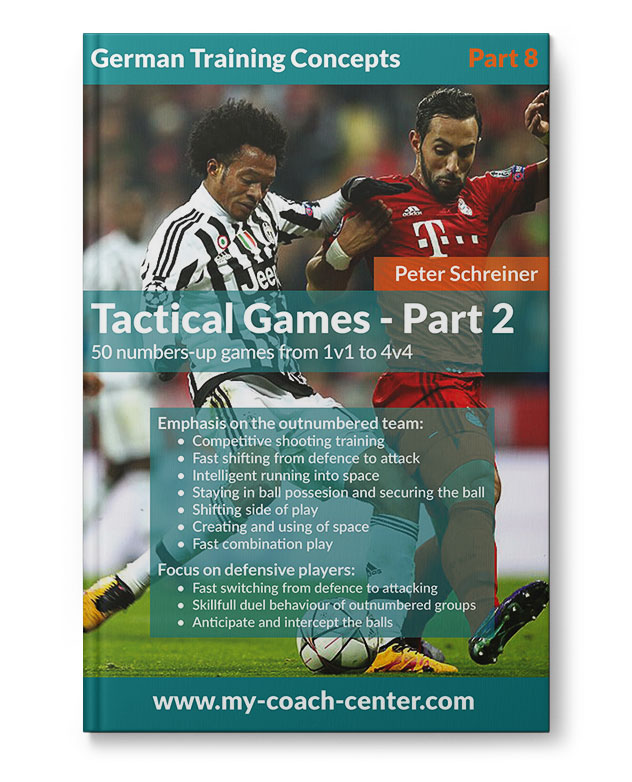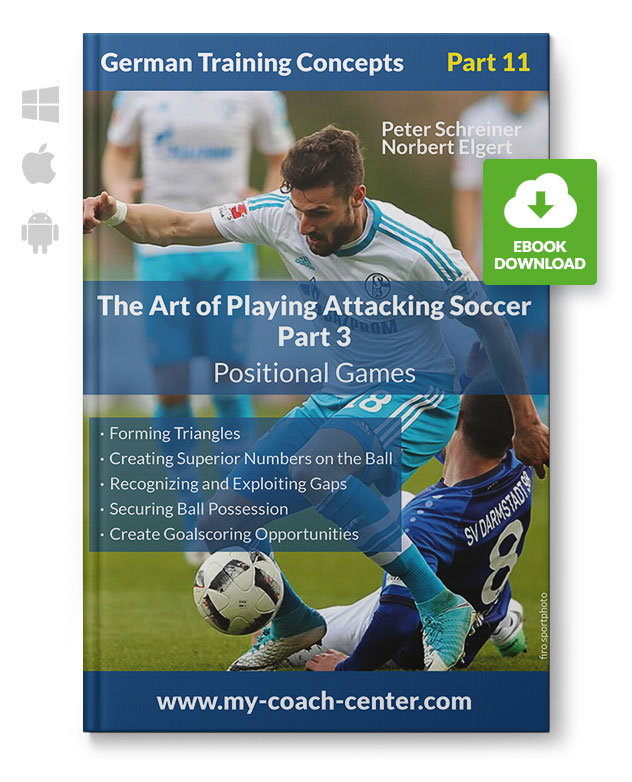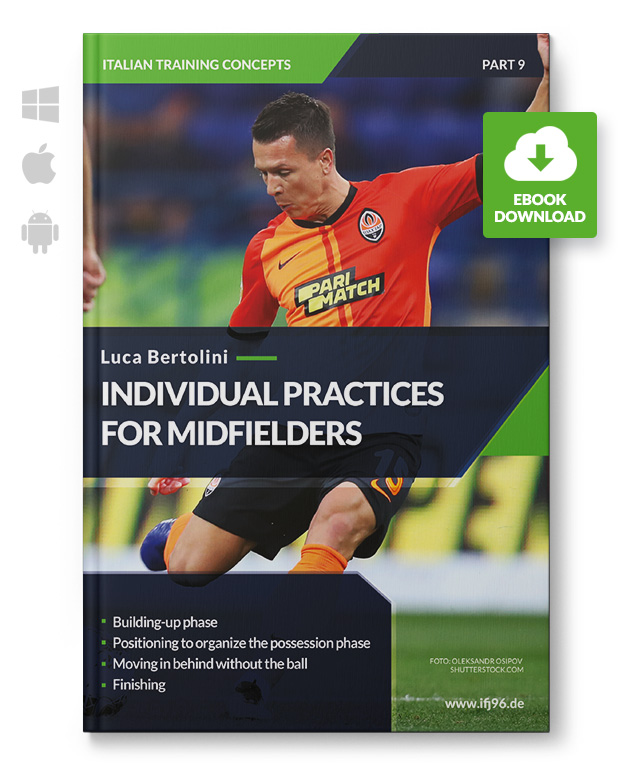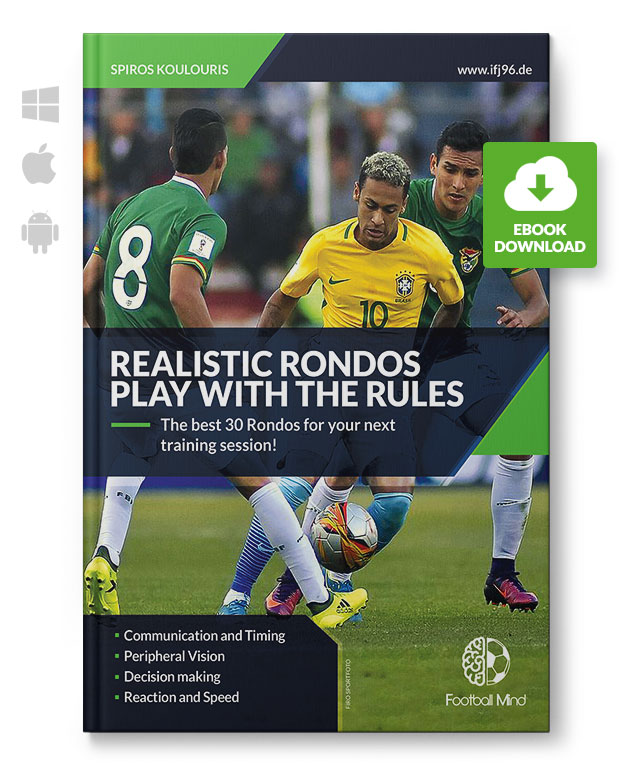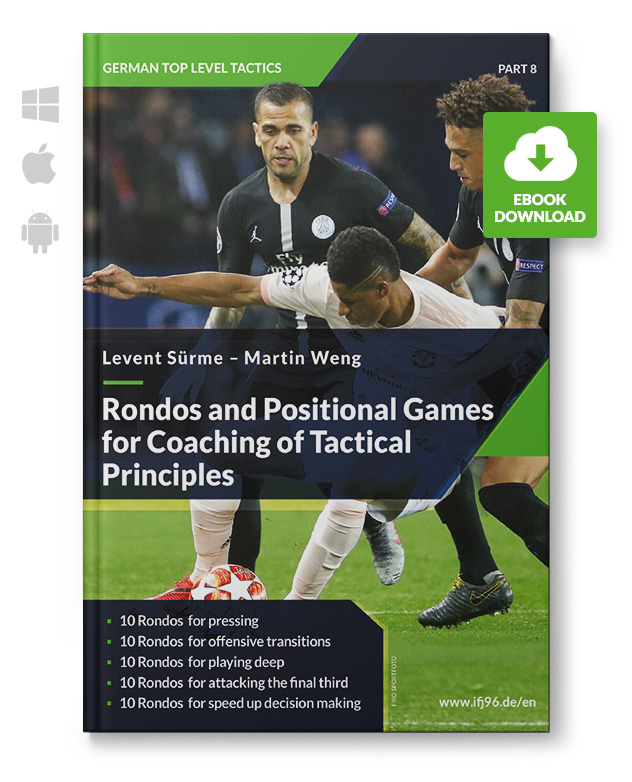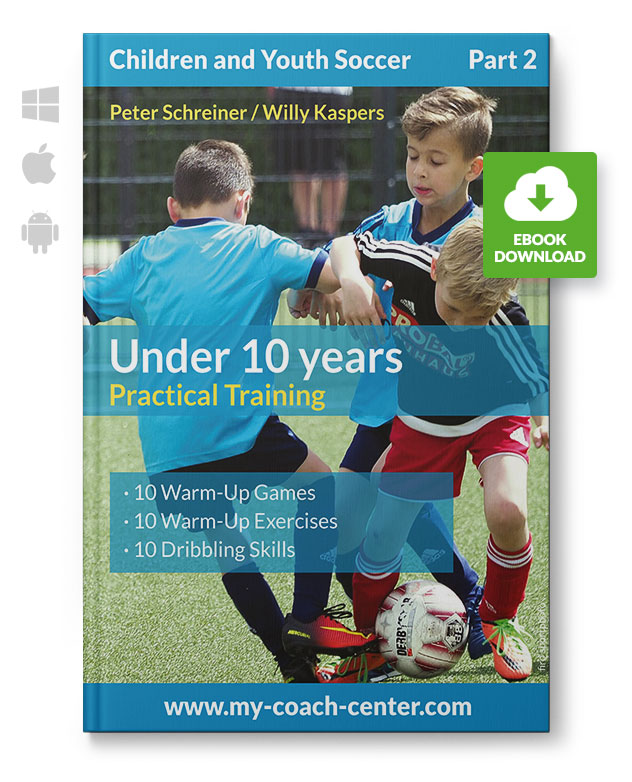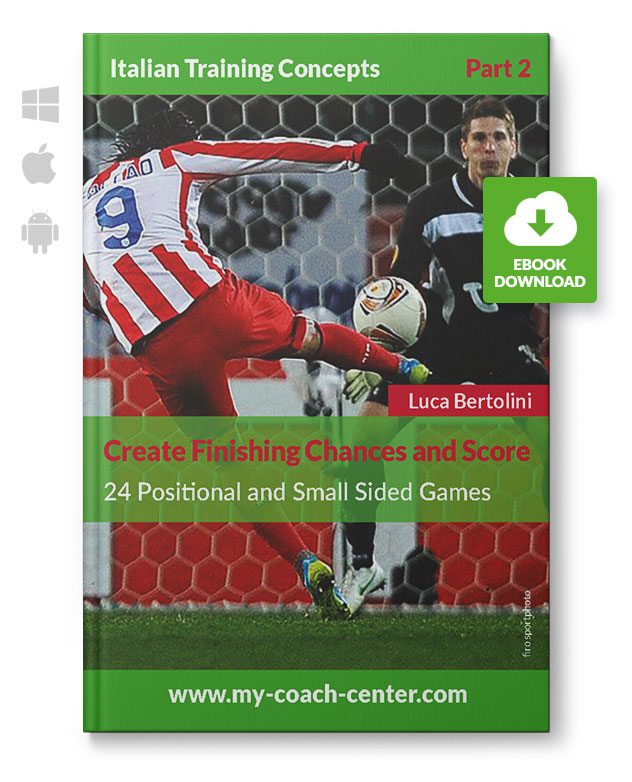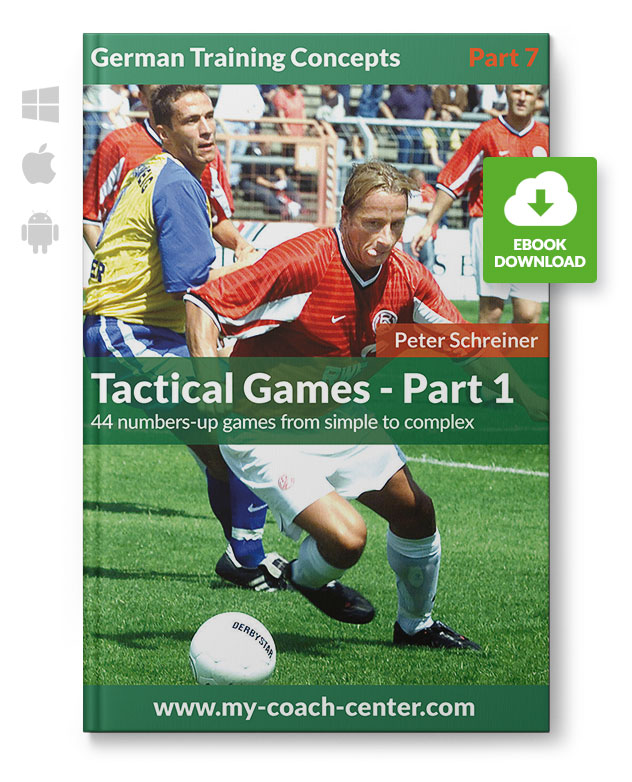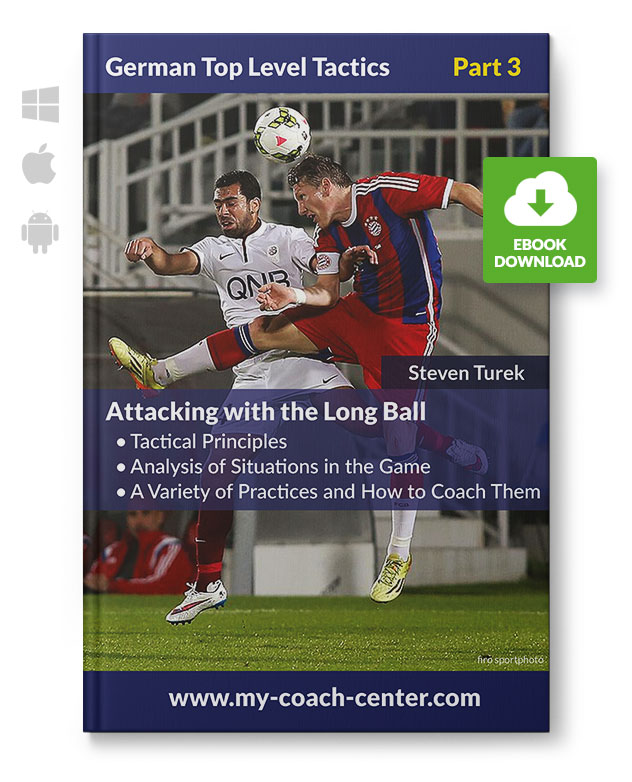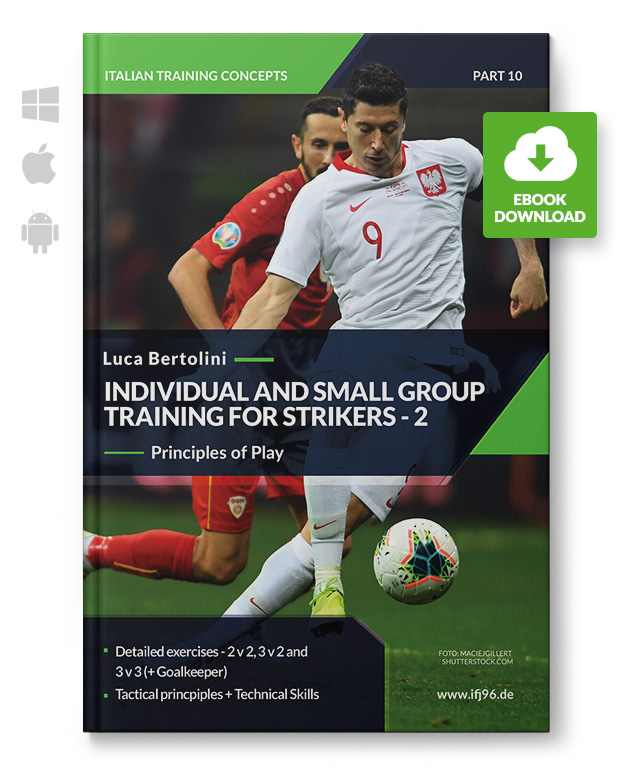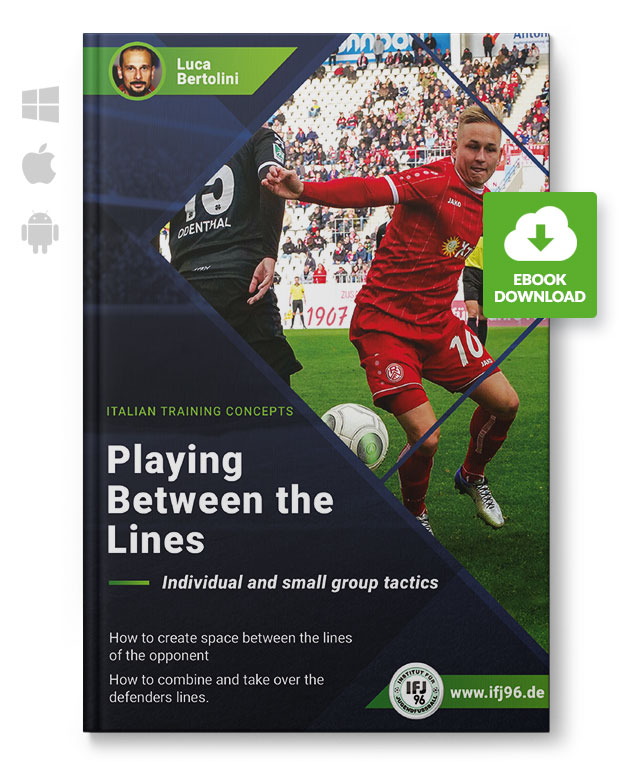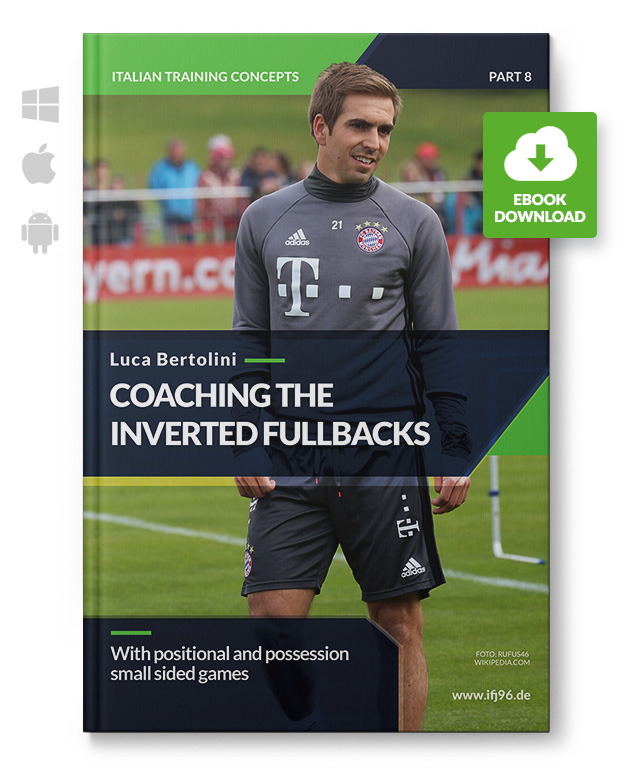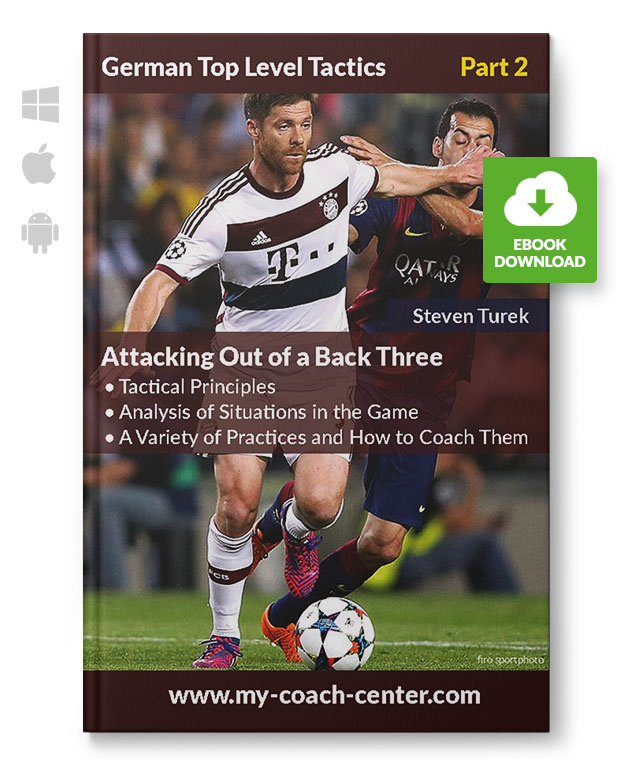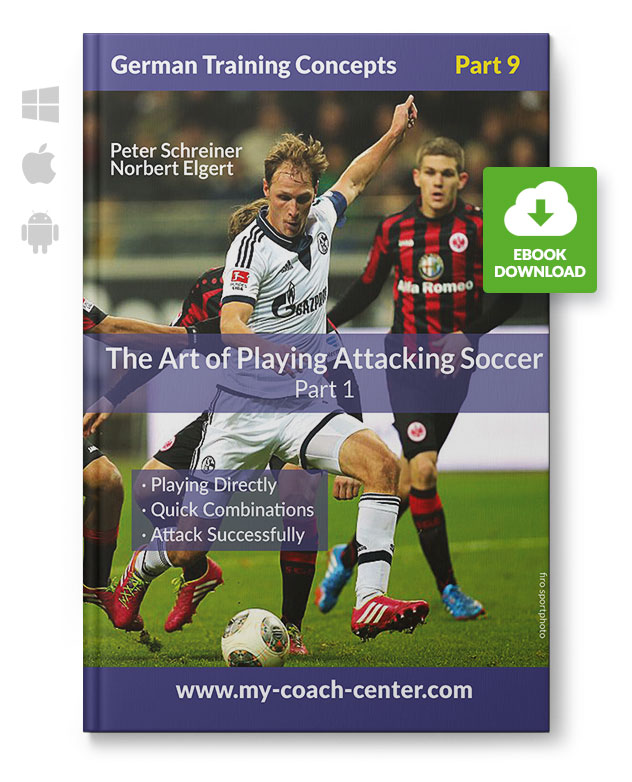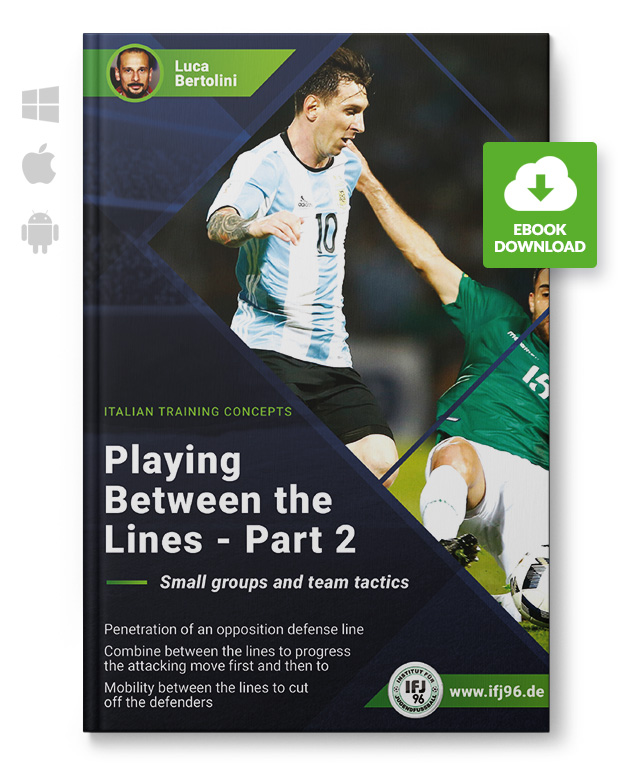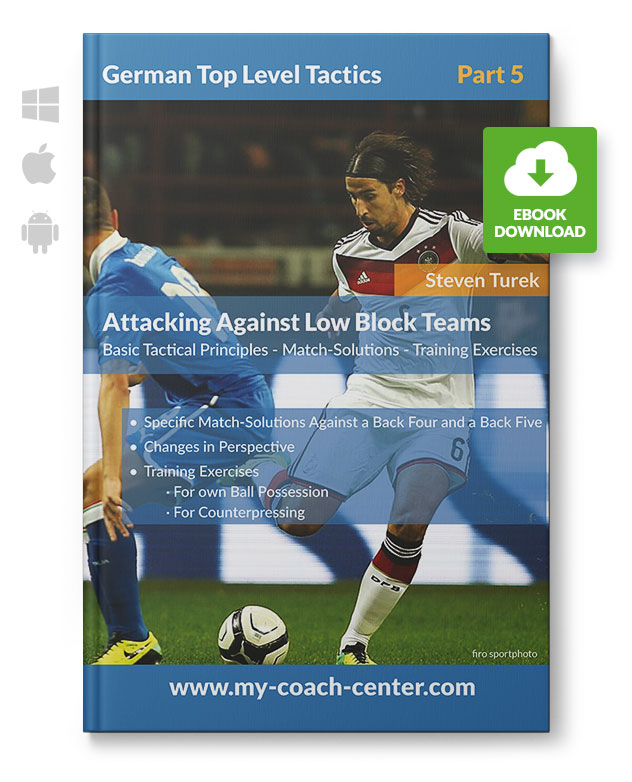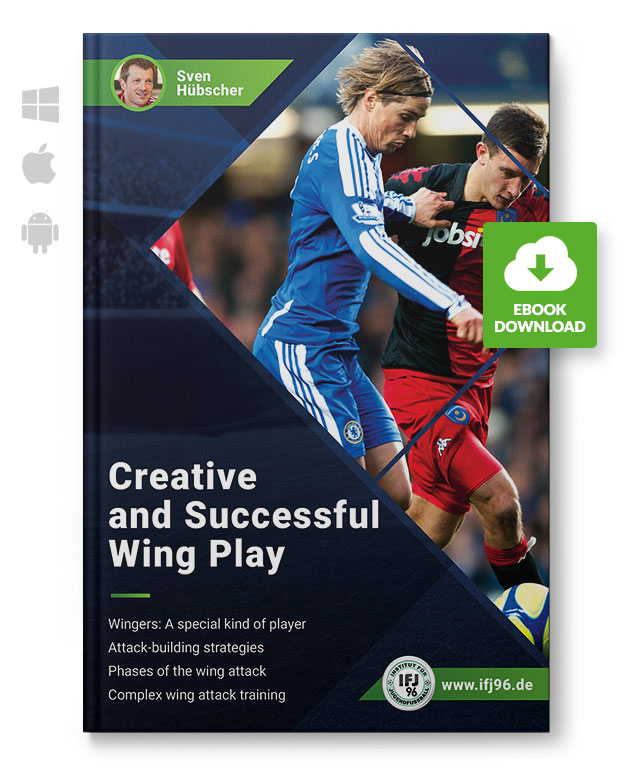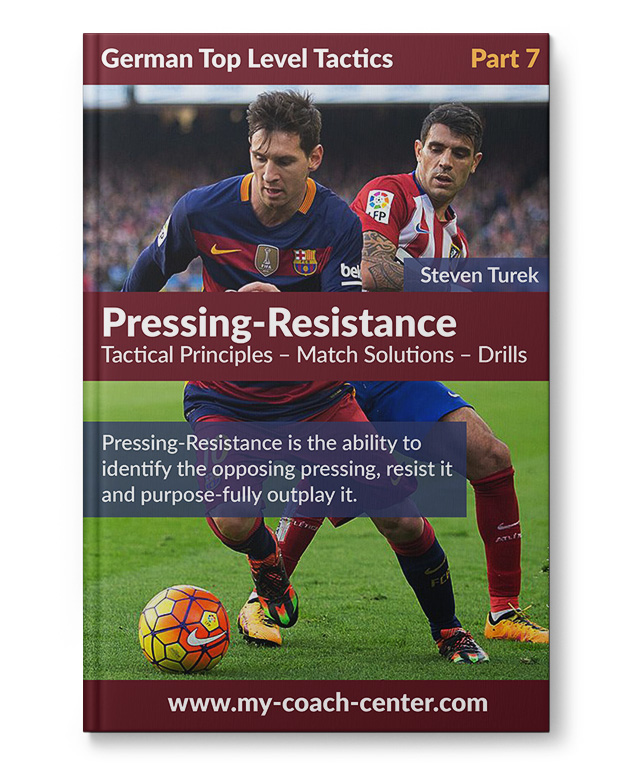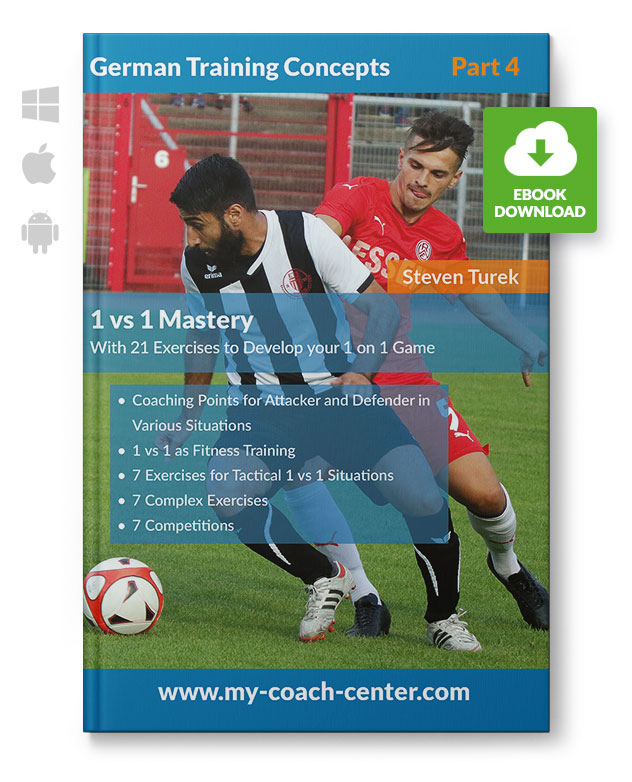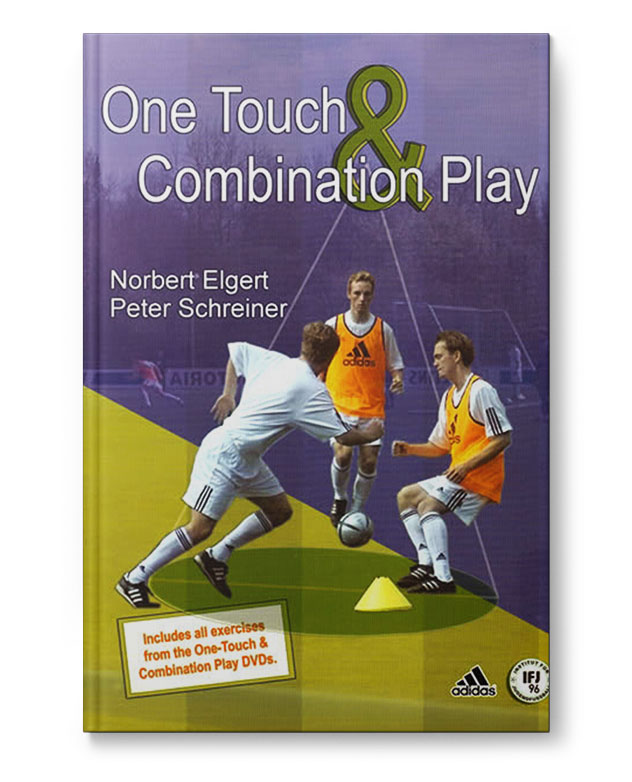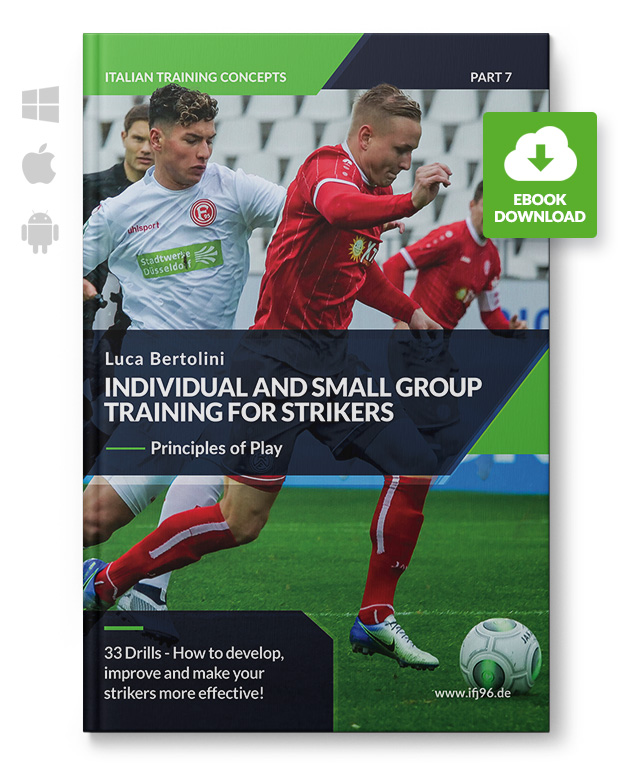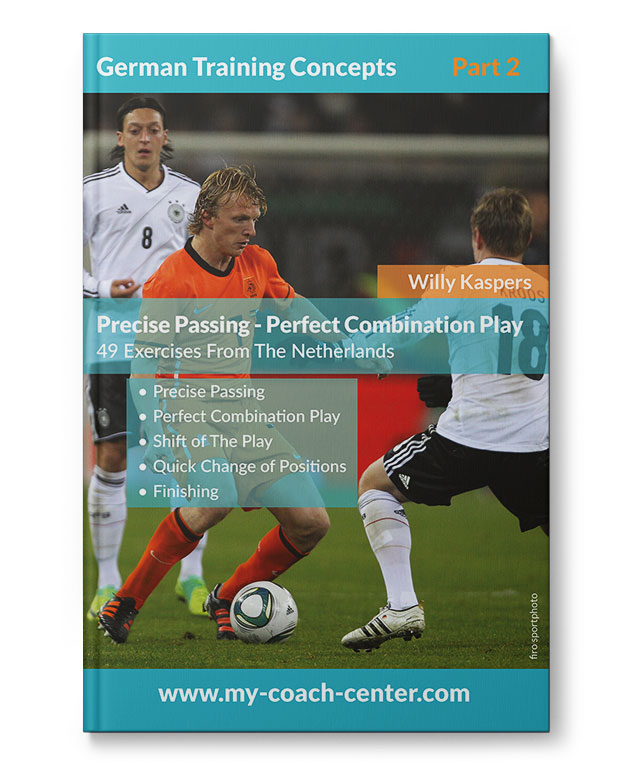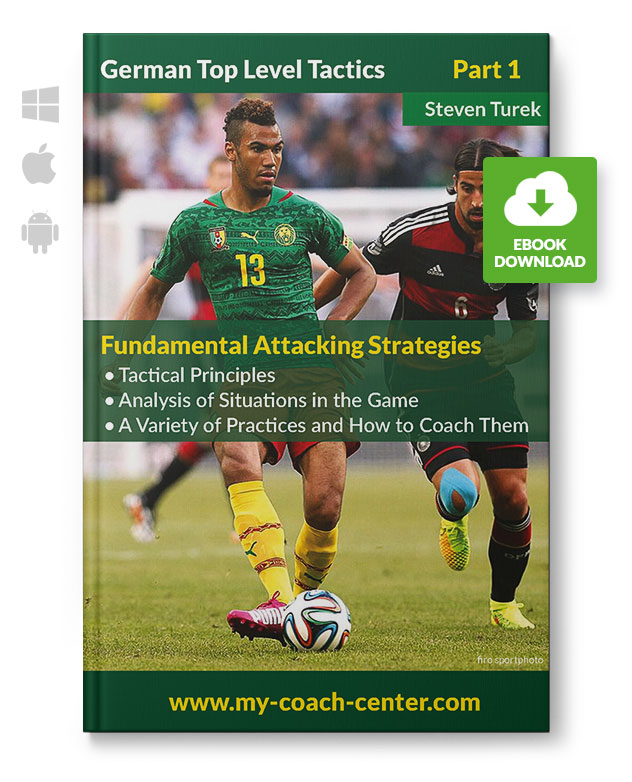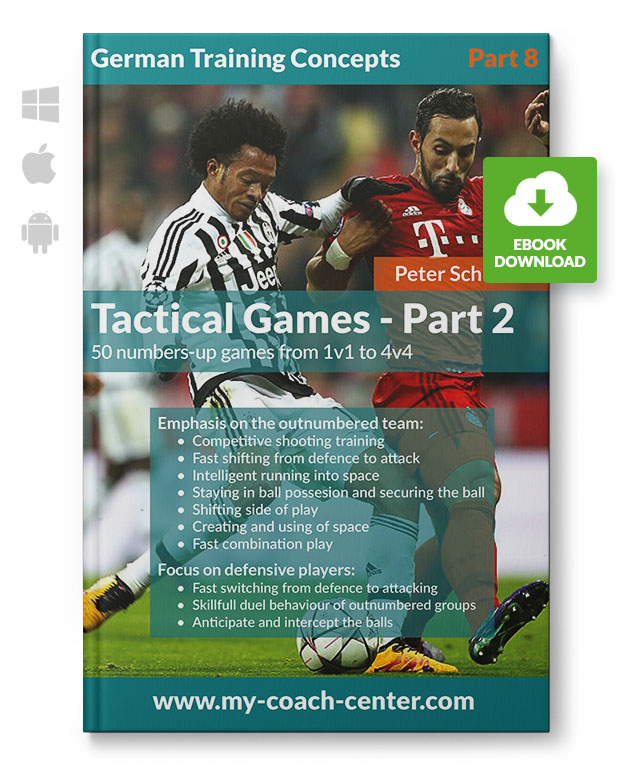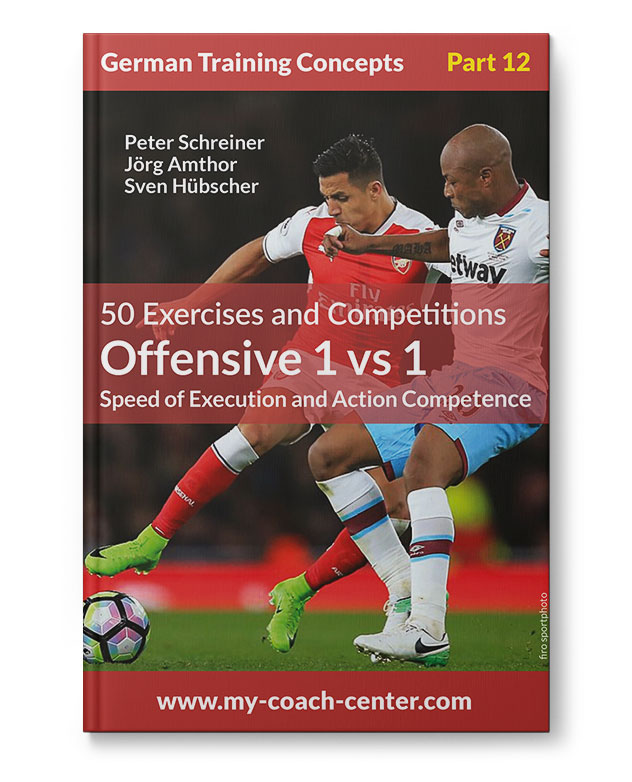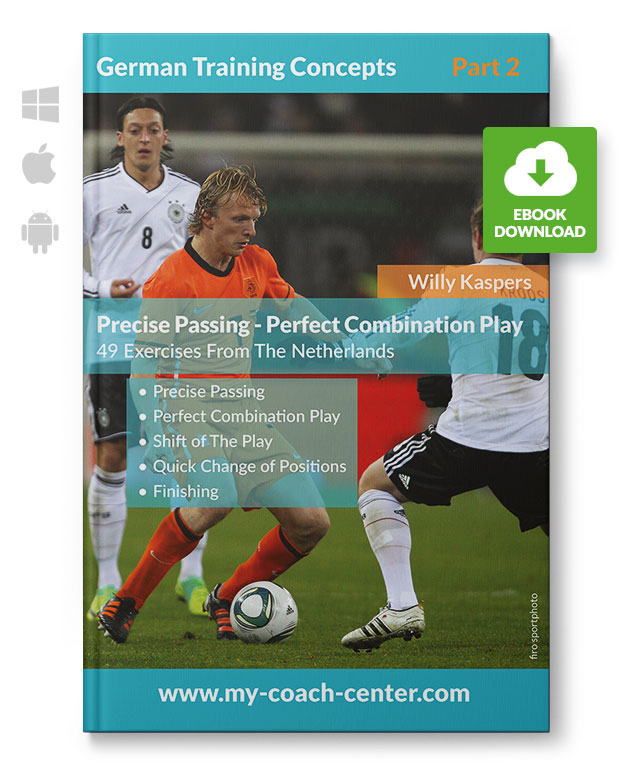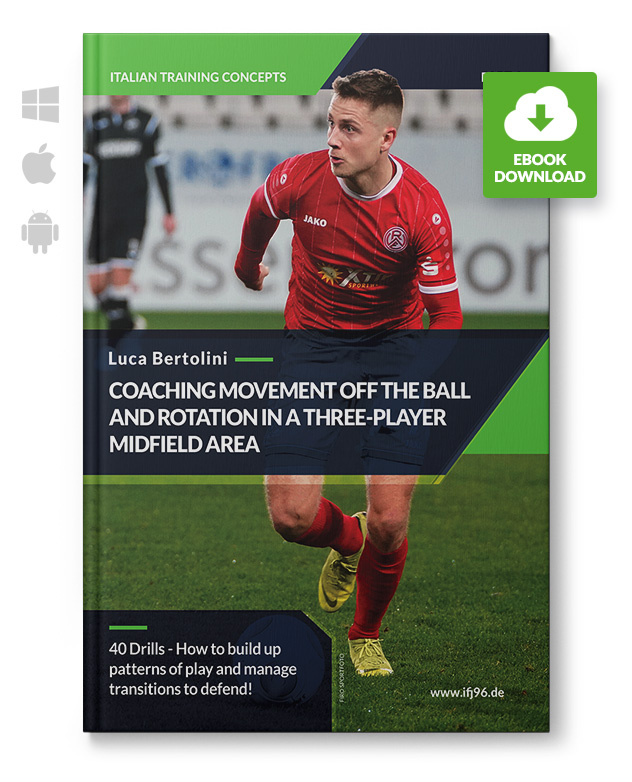Sale %
%
PDF Preview of "Build-Up and score goals with the 3rd man" Author: Athanasios Terzis Publisher: Institute for Youth-Soccer (IFJ96) Pages: 107 Graphics: 79 Drills: 12 The tactics about the 3rd man and the 3rd man’s run which is analyzed in this book, is part of the tactics used by Jurgen Klopp with Liverpool, Julian Nagelsmann with Bayern Munich, Marcelo Bielsa with Leeds United, Pep Guardiola with Manchester City and Luciano Spalletti with Napoli. Specifically, the 3rd man combination is an important element of positional play, in which three attacking players are involved. The objective is to create a free player with available space in advanced position, behind the line of pressure and then move the ball to him. So, when it is applied successfully it can lead in breaking at least one line of pressure. Diagram: 3rd man combination during the execution phase – Moving the ball to the free player The 3rd man combination can be used in several match situations such as when building up from the back in order to break through the pressure applied straight to the GK or to the central defenders. It can also be used against a medium or a low defensive block to help the attacking team break a line of pressure and move the ball to a free player between the lines. Diagram: Breaking through the pressure applied to the GK Except for the 3rd man combination, the book analyses the patterns of the 3rd man’s run that are most frequently used during matches, either in the central areas or wide. The 3rd man’s run, like the 3rd man is also a combination which involves three players. The objective is not to create a free player and move the ball to him, but to move the ball to an attacking player who is on the run, usually behind the defensive line of the opponents. Diagram: 3rd man’s run – 2nd pattern So, if the application of the combination is successful, a goal scoring opportunity can be created. The book will present the most frequently used patterns and the match situations that each specific pattern can be used, as well as how each pattern can be adapted to various formations. Diagram: Pattern 2 of the 3rd man’s run –Applied with the 1-4-2-3-1 formation The analysis of the two combinations (3rd man and 3rd man’s run) is followed by several drills to help coaches apply the analyzed tactics to their teams, by simply adding or adjusting them to their own training sessions.
US$13.95* US$14.95* (6.69% saved)
PDF Preview of "Realistic 1v1 Drills" Author: Spiros Koulouris Publisher: Institute for Youth-Soccer, (IFJ96) Pages: 182 Graphics: 63 Exercises: 35 Videos: 35 Ebook includes detailed Videos of all Drills! Part 1: Theoretical approach of drills & introduction to the training process This particular effort adds to the series of books that have been created with the objective of the realistic approach to soccer training. More specifically, in the 2 parts that make up the complete puzzle of the book, you will discover how the human motor memory mechanisms work and the role that decision-making training plays in the subconscious of children and adults. 1v1 is the first realistic condition that the soccer player encounters in both training and match, and should be trained multifacetedly with creativity and imagination. The drills and games of book should be divided based on the duel scenarios that the football players will encounter during the match. All exercises are accompanied by videos performed by children from the PAOK academy. About the Author Spiros Koulouris was born in Skydra (Greece). He graduated from the Aristotle University of Thessaloniki in the field of science of physical education and sport with specialization in football, holds the UEFA A Licence and since an early age, decided to dedicate himself to coaching. He is the founder of FootballMind. Experience as a Football player: Different clubs until 4th division in Greece Experience as a Football Coach: Former Technical Director at Toumba FC, currently Youth-Football Coach at PAOK FC Teaching Experience Sport Teacher at College of DeLaSalle, Greece Education UEFA A Diploma Degree Physical Education and Sports of Aristotelion University of Thessaloniki ,Greece Conferences Coaching methodology of Futsal football for ages 16 and up (Thessaloniki 2015) Science and football Conference 2015 (England) 2nd Footballabout Conference (Athens) First Aids Conference , Lung and heart function support - use of an automatic external defibrillator (Thessaloniki 2019) 1st Medical Conference by Paok Fc – Groin Pain in Football A-Z (Thessaloniki 2019)
US$24.95*
%
Series: German Training Concepts - Part 3 (eBook) Author: Steven Turek Publisher: Peter Schreiner (Institute for Youth Soccer) Pages: 42 - Graphics: 32 Description: Training exercises and detailed coaching for a perfect play into the depth! In the third part of the series “German Top Level Tactics”, Steven Turek dedicates himself to a tactical topic - The Vertical Play! Thereby, the focus is not specifically laid on tactical nuances, but rather on the mediation in the training process. It is presented what individual and group tactical skills players need in order to implement a highly effective vertical play. Especially the exercises provoking vertical play are attractive for every coach. The second part of the practical training concepts is rounded off by 20 authentic exercises and organizations. All training ideas can cleverly be varied and are easily adaptable to a different number of players. Therewith, the eBook “Effectively Train The Vertical Play” offers an awesome instruction for your own training routine! Fundamental tactical principles in own ball possession and the transition play Ideas and coaching tips for exercises 7 variations in the Y-Pattern 5 exercises in the Diamond 6 exercises in the Tube 5 exercises in the Hourglass
US$13.95* US$14.95* (6.69% saved)
%
PDF Preview of "Tiqui Taca - One Touch - Double Square" Author: Peter SchreinerExpert Advice: Peter HyballaPublisher: Institute for Youth-Soccer, (IFJ96) Pages: 64 - Graphics: 45 Tiqui Taca - One Touch - 45 Variations of the Double Square Diagonal - Drop - Diagonal Precise Passing & Combination Play Game Forms with Pressing, Counter Pressing and Shot on Goal Coaches often look for training forms that are versatile and easy to set up. The double square fulfills these requirements and is extremely versatile as a training form. It is particularly suitable as a complex passing and combination exercise during the warm-up. A big advantage of the double square is that the variations can easily be adjusted to the number of players. This way, you can perfectly warm up the whole team or groups of 10 or more players with different pass sequences. Simply vary the field size and the task and thus achieve different training goals with one training form. Table of Contents Passing in the Double Square Double Square - Dribbling to the Start Double Square - Passes Through Dummy Goals Double Square - Pass to the Start Double Square with 8 Center Players and 2 Balls Double Square with 8 Center Players and 4 Balls Double Square – Long Ball to the Start Double Square - Pass to the Goalkeeper Double Square - Wall Pass C with D Double Square - Wall Pass A with C Double Square - Double Wall Pass Double Square - Playing Over the Third Man Double Square - 2 Additional Wall Passes Outside Double Square - 4 Additional Wall Players Outside Double Square with “Diagonal-Drop-Diagonal” Outside Double Square with Overlapping Double Square with Coordination Double Square with Shot on Goal 1 Double Square with Shot on Goal 2 Double Square with Overlapping and Shot on Goal Double Square with Corridor Player Double Square - 4 Plus 1 v 3 Double Square - 6 Plus 2 v 3 Double Square - 4 Plus 2 v 3 Double Square - 8 Plus 2 v 4 Game Forms in the Double Square Double Square - 3 v 1 Plus 6 Double Square - 3 v 1 Plus 5 Double Square - 3 v 1 Plus 4 Double Square - 4 v 2 Plus 6 Double Square - 4 v 2 Plus 5 Double Square - 4 Against 2 Plus 4 Double Square - 5 v 2 Plus 8 Double Square - 5 v 2 Plus 7 Double Square - 5 v 2 Plus 6 Double Square - 5 v 2 Plus 5 Double Square - 5 v 2 Plus 4 Double Square - 6 v 2 Plus 10 Double Square - 6 v 2 Plus 9 Double Square - 6 v 2 Plus 8 Score over the inner Square Double Square - 5 v 5 Plus 1 (2 v 1 in Inner Square) Double Square - 6 v 6 Plus 2 (4 v 2 in Inner Square) Double Square Game Forms with Goal Shot Double Square - 6 v 3 with Goal Shot - Passes into the Inner Square Double Square - 8 v 4 with Goal Shot - Passes into the Inner Square Double Square - 3 v 1 Plus 4 with a Goal Shot Double Square - 4 Against 2 Plus 4 with a Goal Shot Double Square - 5 v 2 Plus 7 with a Shot on Goal Double Square - 5 v 2 Plus 8 with 2 Goalkeepers
US$13.95* US$14.95* (6.69% saved)
%
Authors: Peter Schreiner, Jörg Amthor, Sven Hübscher Pages: 64 Graphics: 50 Exercises: 50 Offensive 1 vs 1 - 50 Exercises and Competitions Speed of Execution and Action Competence Dribbling exercises with a focus on ball control, twists, changes of direction and tempo changes certainly have their justification and are particularly useful in basic training if they are used in doses. The skills learned in basic training should then be developed as early as possible application-oriented in exercises and competitions. The successful design of offensive 1 vs 1 situations is always a great challenge for an attacker, because most defenders are well-trained in defensive tackling and also experience shows that they are extremely physical. Therefore, players in all leagues and levels are still very much in demand, who are capable of playing relentlessly attacking opponents in order to open rooms, to create a numerical majority, or to finish on the goal unchallenged. Players like Arjen Robben, Ronaldo, Franck Ribery, Lionel Messi, Alexis Sanchez or Neymar have a dribbling success rate of around 40-70%, which makes the difference. Which skills are necessary? What characterizes all these players - what makes them different? First of all, all these players master almost all known dribbling techniques, body delusions and feints from the bottom up and apply them flexibly to the situation. In addition, they have extremely high basic dynamics and an explosive start. Her body control is phenomenal and the action density is very high. But these factors alone are far from enough to describe the level of these world class players. They are characterized by additional skills with which they can decide games on their own: These world-class players are fast-reacting to the fast-changing and complex game situations (space, teammates and opponents, ball movements, etc.) and make almost intuitively correct decisions based on their experience. The key words for this are "Speed of Execution", and "Action Competence". Example - Drill 35 - Double 1 vs 1 on staggered goals Organization/Structure Playing field 40 x 40 m, set up two goals with neutral goalkeepers diagonally opposite. Additionally, mark two counter lines with pylons. Divide two teams and have them lined up diagonally opposite. Balls in both goals. Procedure • Both goalkeepers simultaneously play a flat pass (1) into the run of the • sprinting attacker A (1) • With the pass, the defenders sprint into the field and attack the • Attacker as far as possible away from the goal (1) • The attacker A should immediately receive the ball into the direction of the goal (2), dribble past B and finish (see graphic on the left) or play off B and finish (see graphic on the right) (3) • Wins B the ball, he counters as quickly as possible on the counter-line • The attackers and the defenders face each other on opposite sides Variation • The goalkeeper opens with a throw, a long ball or vertically on the other attacker Variation Dribbling exercises with a focus on ball control, twists, changes of direction and tempo changes certainly have their justification and are particularly useful in basic training if they are used in doses.
US$13.95* US$14.95* (6.69% saved)
%
Author: Steven Turek Pages: 60 - Graphics: 53 Pressing-Resistance Tactical Principles – Match Solutions - Drills Steven Turek: „Pressing-Resistance is the ability to identify the opposing pressing, resist it and purposefully outplay it.“ Every coach knows the situation: The own team builds up the play and is early pressured on. Passes are desperately played from one player to the other, until one clears the ball long. What’s needed in these situations is call pressing-resistance. The ability to identify the opposing pressing, break it and purposefully outplay it! In order that your team becomes individually as well as team-tactically more pressing-resistant, you’ll find the following chapters in the eBook: Tactical principles to identify the opposing pressing Valuable changes of perspectives Fundamentals for an individual skillset to break pressing Specific Strategies to solve a blocked goal-kick Match solutions for the play on the wing and in the center Practical training exercises for a perfect transfer onto the pitch A core element of most offensive strategies, is usually the attempt to press the opponent into motion, more precisely, into sprinting. Pressing distinguishes itself by players creating high pressure on the ball carrier. Why don’t we consequently consider that opposing pressure in a positive way and use it for our own strategy? That’s exactly the aspect I want to discuss in “Pressing-Resistance”. „The opponent only has ten players as well. If he creates numerical advantage somewhere on the pitch, somewhere else has to be a numerical disadvantage - that’s simple logic.” (Carlo Ancelotti) Exploit the weak points of the pressing! “If a coach considers the opposing pressing in a positive way, strategic aspects become more important, because: Behind every good pressing strategy is an idea, how the ball is supposed to be won. To counter that strategy, I developed all kinds of match solutions, which orient on common pressing strategies and specifically focus on weak spots. To focus on these weak spots, it can happen that specific types of players find themselves in unfamiliar positions on the pitch. Therewith, I purposefully want to provide suggestions and break up common thinking patterns.” (Steven Turek) Chances and Risks If Pressing-Resistance is successfully implemented, different advantages emerge: A favorable ratio of players in the attack after successfully outplaying the first pressing-line Adjustment-Mechanisms of the opponent (for example quick dropping towards their own goal, strategic fouls and so on) Demoralization of the opponent, when pressing-strategies don’t work
US$13.95* US$14.95* (6.69% saved)
Author: Peter SchreinerPages: 52Graphics: 44Exercises: 44 Tactical Games - Part 1 44 numbers-up games from simple to complex How do players learn how to hold the ball, run free properly and recognize gaps in their opponent’s defence and use them at lightning speed? How do you convey a clever game in depth, a surprising game shift with a final goal kick?In this book Peter Schreiner presents 44 systematically ordered tactical games to convey important tactical behaviours in attack and defence. Attack: Staying in ball possession (determine playing speed) Running intelligent (use gaps) Shift side of the field Triangular formations Double pass and fast combination play Playing in depth and exploiting goal-scoring opportunities Defence: Skilful duel behaviour Delay an attack Provoke mistakes Anticipate and catch balls The 44 tactical games are well illustrated and contain important information about the organisation, the structure of the exercises, the procedures, possible variants, as well as additional tips and suggestions. Overview of the exercises: 20 exercises 3 v 1 16 exercises 4 v 2 8 exercises 6 v 4
US$14.95*
AuthorPeter Schreiner Pages52 Pages Drills50 Practices LevelU11-PRO Tactical Games - Part 2 50 numbers-up games from 1v1 to 4v4 The second part of the “Tactical Games” is about position games with neutral players from 1 against 1 to 4 against 4, vary the number of “Jokers” and their position inside and outside the field. Help the players getting as many chances to score and then use them perfectly. With the tactical games of this book the following focal points can be coached: Emphasis on the outnumbered team: Competitive shooting training Fast shifting from defence to attack Intelligent running into space Staying in ball possesion and securing the ball Shifting side of play Creating and using of space Fast combination play Focus on defensive players: Fast and smart counter attack Fast switching from defence to attacking Skilful duel behaviour against outnumbered groups Provoke mistakes of the attackers Anticipate and intercept the balls With the 50 tactical games Peter Schreiner gives you many ideas for a varied tactical training. They are well illustrated and contain important information about the organisation, the structure of the exercises, the procedures, possible variants, as well as additional tips and suggestions. Overview of the exercises: 11 exercises 1 v 1 11 exercises 2 v 2 13 exercises 3 v 3 15 exercises 4 v 4
US$14.95*
%
Authors: Peter Schreiner, Norbert Elgert Pages: 48 Graphics: 26 Exercises: 22 The Art of Playing Attacking Soccer - Part 3 - Positional Games Forming triangles - Creating superior numbers on the ball - Open body position - Recognizing and exploiting gaps - Securing ball possession The third part of the series "The Art of Playing Attacking Football" is all about the importance of a good positional game as a requirement for successful positional attacks. A positional attack is always started when a fast counterattack isn’t possible. It is characterized by a secure build-up from the back and safe passing sequences from the first third over the midfield in the attack zone to prepare goalscoring opportunities.
US$13.95* US$14.95* (6.69% saved)
%
PDF Preview of "• Individual practices for midfielders" Italian Training Concepts - Part 9 Individual practices for midfielders Author: Luca BertoliniPages: 71Graphics: 48Exercises: 46 There is an era of midfielders before Pep Guardiola and another era after his seasons at Barcelona; Busquets, Xavi, and Iniesta have changed the positions in the field and the meaning of the word, and the role. Following the word, midfielders are the players who stand and act in the middle third of the field; from this point of view, Steven Gerrard and Frank Lampard have already changed the role, creating the box-to-box midfielders. On the other side, Guardiola's Tiki-taka is over at this stage of tactical developments. However, the consequences of this period are still affecting soccer, as he created the attacking midfielders, "using" Busquets as holding and defensive midfielder in front of the defensive line. In his proper definition, a holding midfielder is probably the purest form of a defensive midfielder, as he holds his position close to the team's defense. There are 3 types of midfielders that protect the back defensive line, launch the building-up phase, and support the consolidation and possession phases of play. The proper defensive midfielder, the holding or deep-lying midfielder, and the deep-lying playmaker. Other types of categorized midfielders are the hybrid midfielder, who doesn't help the defense as a first task, but he acts as the game's flow requires, or the box-to-box midfielder, who plays with excellent Positioning, defensively and offensively. Are the wingers midfielders? Or do these players act in a completely different role? Are the inverted fullbacks midfielders? The wingers become "Mezzale" in the building up and defensive phases of the 1-4-4-2. If the mezzale are destructive players, they become Mediano(s). Jürgen Klopp and Pep Guardiola have created the final review of the midfielder's role definition in Germany and England; the inverted fullbacks allowed the midfielders to act as attackers and push up fullbacks have required the wide midfielders to patrol the half-spaces and the flanks at the back. The No.10s are now midfielders, attacking and pressing midfielders. Even though they are not frequently immediately involved in the building up phases, they are now points of reference in the possession, consolidation, and finishing stages of the moves. Eventually, technical skills, flexibility, awareness, and peripheral vision are the main requirements for a midfielder who must: Support the building-up phase Allow a center back to stand wider Move the ball at the back Allow a center back to stand wider Cut off the pressure lines Allow a center back to stand wider. Use the goalkeeper as a back apex to create a 3 v 2 duel Manage the ball in the middle third (possession and consolidation phases) Back apex, behind the attacking lanes, and in front of the defensive line. Support the finishing stages of the moves. These are the situations of play which the book aims to coach.
US$13.95* US$14.95* (6.69% saved)
%
Author: Spiros Koulouris Edited by: Peter Schreiner Publisher: Institute for Youth-Soccer, (IFJ96) Pages: 51Graphics: 30Exercises: 30 In this eBook, coach Spiros Koulouris shows you the best 30 rondos for your next training session. With the help of rondos, improve your players communication and timing, peripheral vision, reaction, speed and the ability to make the right decision faster! Train every football habit on the pitch, with game like situations, challenging objectives and rules, that will motivate your players to mentally and physically give it their best! The rondos in this eBook are suitable for any age group and can be implemented anytime during the season. Every rondo is described and illustrated in great detail, with training objectives (technical, tactical and mental) and specific rules for each position (possession players and defenders). Topics The FootballMind Philosophy The Importance of Rondos The rondo is the best way to introduce these important habits to your players in a simple way and with the opponent’s resistance. The Importance of Rondos FootballMind Innovative Rondos When to Use a Rondo? Emphasis on the Details & Rules Number of Players - Size of the Rondo Opponents in the Rondo Repeat Successful The Meaning of “X” Passes Points - Change Roles Peripheral Vision Communication Timing Decision Speed About the Author Spiros Koulouris was born in Skydra (Greece). He graduated from the Aristotle University of Thessaloniki in the field of science of physical education and sport with specialization in football, holds the UEFA A Licence and since an early age, decided to dedicate himself to coaching. He is the founder of FootballMind. Experience as a Football player: Different clubs until 4th division in Greece Experience as a Football Coach: Former Technical Director at Toumba FC, currently Youth-Football Coach at PAOK FC Teaching Experience Sport Teacher at College of DeLaSalle, Greece Education UEFA A Diploma Degree Physical Education and Sports of Aristotelion University of Thessaloniki ,Greece Conferences Coaching methodology of Futsal football for ages 16 and up (Thessaloniki 2015) Science and football Conference 2015 (England) 2nd Footballabout Conference (Athens) First Aids Conference , Lung and heart function support - use of an automatic external defibrillator (Thessaloniki 2019) 1st Medical Conference by Paok Fc – Groin Pain in Football A-Z (Thessaloniki 2019)
US$13.95* US$14.95* (6.69% saved)
%
PDF Preview of "Rondos and Positional Games for Coaching of Tactical" German Top Level Tactics - Part 8Rondos and Positional Games for Coaching of Tactical Authors: Levent Sürme, Martin WengPages: 87Graphics: 61Exercises: 50 50 Rondos and Positional Games It is well known, that each training session consists of several parts. Rondos are now a firmly planned element in almost every session. There are probably very few coaches in the world who don’t include them in practices. Usually built in a rectangle, for example exercises in 4:4 + 2 or similar take place. In particular, Pep Guardiola, during in his time at FC Barcelona and later at FC Bayern Munich, made positional games more and more popular in many variations. But each Rondo has its own details and outcomes. This eBook includes: 10 Rondos for pressing 10 Rondos for offensive transitions 10 Rondos for playing deep 10 Rondos for attacking the final third 10 Rondos for speed up decision making Of particular value is the information regarding coaching, organization and possible variations. Peter Schreiner - IFJ96 The ebook by Levent Sürme and Martin Weng is something quite special. Very good, tactical preliminary remarks clarify the authors’objective: Five main topics (pressing, going on the offensive, in-depth playing, playing in the final third and swiftness of action) are introduced using vivid examples from professional soccer and impeccably rehearsed on the basis of 10 game forms. Of particular value is the information regarding coaching, organization and possible variations. This allows every coach to implement the rondos and game forms presented in targeted fashion during training, and thus prepare his players in motivated and diversified fashion for the demands of the 11 against 11 game. About the authors Levent Sürme Levent Sürme joined FC Augsburg at the age of 7 until he was 19. 2003, after he had to quit due to an injury, he started working for FC Augsburg as a youth coach for the U8 team. He has got the UEFA “A” Licence and worked under Thomas Tuchel and Manuel Baum who were head of the academy. He was head coach at FC Augsburg for 15 years. U8-U17. Last three years head coach of the U17 Bundesliga-Team. From 2018 to 2020 he was the head coach of the U15-Team at RB Leipzig. With the beginning of this season he works for SKY as an analyst for the Champions League matches. He also holds seminars for some Football-Associations in Germany and the Turkish-Football-Federation. Martin Weng Martin Weng joined FC Augsburg at the age of 11 and played there until the U19 team. After that he played for several years in the amateur field and started his coaching career at the age of 28 as a player-coach. He has got the UEFA “A” Licence and studied business administration (diploma thesis was the marketing of FC Augsburg). From 2016 to 2018 he was assistant coach of the FC Augsburg U17 Bundesliga-Team. Since 2018 he is head coach of the first team at the bavarian amateur club FC Gundelfingen. He is also coach at the talent development programm from the german football association (U11-U14).
US$13.95* US$14.95* (6.69% saved)
%
Authors: Schreiner, Kaspers Pages: 72 Exercises: 30 Level: U7-U10 PDF Preview of "Under 10 years" Under 10 years Practical Training In part 2 of the series “Children and Youth Soccer”, Peter Schreiner and Willy Kaspers will present 10 warm-up games, 10 warm-up exercises and 10 training forms for dribble training. The authors attach particular importance to the fact that all forms of training and competitions are practical, age-appropriate and immediately implementable. They present these very vividly with the help of meaningful drawings and understandable descriptions. The presented contents can be transferred to other age-groups as well. They should be modified by adjusting the size of the pitch, the number of players, the task and the provocation rules.
US$13.95* US$14.95* (6.69% saved)
%
Italian Training Concepts - Part 2 Create Finishing Chances and Score - 24 Positional and Small Sided Games Author: Luca Bertolini Edited by: Peter Schreiner Editor: Institute of Youth Soccer, Essen – Germany Pages: 48 Graphics: 38 Description: In this second e-book by Luca Bertolini the main theme is the organization of positional games involving eleven players (goalkeeper included) with the three classic roles of these games: players with possession, without possession and free players as support to the team with possession. One of the main goals is to create always numerical superiority for the players in possession to allow them to have the chance to finish and score. The most important difference with all the other positional possession games is that all the free players are placed in crucial roles in the games as they would have in the most important systems of play we see on the pitch in modern soccer: 1-4-3-3, 1-4-2-3-1, 1-3-5-2, 1-4-4-2. Another interesting focus of this e-book are the never-ending transitions phases of the exercises; the goal to score is always the same and for this reason when the defenders recover the ball they must replace themselves on the pitch looking for the help of the free players and they look for it again when they have to organize a new attacking move. It would be very interesting to find a physical training point of view on the games; as they are small sided games, with the coach who always kicks new balls inside the pitch, they can be useful also for athletic workouts for the players, changing the role every established limit of time. The sequence of the exercises depends on the level of complexity as the games are always organized with a goalkeeper and 4 vs 4 duels with two free players or 3 vs 3 duels with four free players; all these games are easier for the attacking team as one of the main goal is to create finishing chances and score.
US$13.95* US$14.95* (6.69% saved)
%
Author: Peter Schreiner Pages: 52 Graphics: 44 Exercises: 44 Tactical Games - Part 1 44 numbers-up games from simple to complex How do players learn how to hold the ball, run free properly and recognize gaps in their opponent’s defence and use them at lightning speed? How do you convey a clever game in depth, a surprising game shift with a final goal kick? In this book Peter Schreiner presents 44 systematically ordered tactical games to convey important tactical behaviours in attack and defence. Attack: Staying in ball possession (determine playing speed) Running intelligent (use gaps) Shift side of the field Triangular formations Double pass and fast combination play Playing in depth and exploiting goal-scoring opportunities Defence: Skilful duel behaviour Delay an attack Provoke mistakes Anticipate and catch balls The 44 tactical games are well illustrated and contain important information about the organisation, the structure of the exercises, the procedures, possible variants, as well as additional tips and suggestions. Overview of the exercises: 20 exercises 3 v 1 16 exercises 4 v 2 8 exercises 6 v 4
US$13.95* US$14.95* (6.69% saved)
%
eBook Series: German Top Level Tactics - Part 3 Tactical Principles Analysis of Situations in the Game A Variety of Practices and How to Coach Them Author: Steven Turek Edited by: Peter Schreiner Translated by: Tjorben Becker Editor: Institute of Youth soccer, Essen - Germany (www.soccer-coaches.com) Pages: 56 - Graphics: 42 Content: The third part of the series “German Top Level Tactics” thematizes attacking with the long ball. In the known pattern “Fundamental Principles - Match-Situation - Exercises”, Steven Turek answers among many others topics, the following questions: What technical and tactical skills requires a team willing to attack with long balls? How can I effectively use the shifting movement of the opposing team for my purposes? Which solutions can precisely be implemented during the match? Which mechanisms are necessary in case of losing the ball? Which coherence exists between attacking with long balls and counterpressing? After these basics, concrete match-situations will be described. The situations will be illustrated with detailed explanations, possible error sources and “what-if-situations”. The book is rounded off by a well balanced practical part in which different exercises for all ages are explicitly described.
US$13.95* US$14.95* (6.69% saved)
%
PDF Preview of "Individual and Small Group Training for Strikers - 2" Italian Training Concepts - Part 10 Individual and Small Group Training for Strikers - 2 Author: Luca BertoliniPages: 75Graphics: 54Exercises: 34 This book has the goal to coach the strikers from an individual point of view, involving them in 2 v 2, 3 v 2, and 3 v 3 (+ goalkeeper) situations to improve their individual cooperation and technical skills and to let them learn how to play focusing on tactical principles of play: 2 striker v 2 defenders + goalkeeper: striker with the ball at his feet and striker without the ball at the beginning. 3 strikers v 2 defenders + goalkeeper: 1 striker with the ball at his feet and 2 strikers without the ball at the beginning. 3 strikers v 2 defenders + goalkeeper: 3 strikers without the ball at the beginning. 3 strikers v 3 defenders + goalkeeper: 1 striker with the ball at his feet and 2 strikers without the ball at the beginning. 3 strikers v 3 defenders + goalkeeper: 3 strikers without the ball at the beginning. To cooperate and be linked with teammates and to act against more than one defender (numerical advantage or equality situations) are only tools to coach the players as unique actors; there aren't any connections with systems of play but with principles of play. The area of the field where the practices are set up is the final third, considering the division of the field into attacking sub-areas that the positional play philosophy inspires. The final third is divided into three 6 areas (2 along the flanks and 2 in the center). Small-sided games are widely used during soccer practices, and they enable players to experience situations they encounter during matches. On the other hand, small-sided games aren't enough to coach the strikers (and the defenders) despite leading them to develop their technical and tactical skills. Apart from technical skills coaching and individual tactical objectives of the small-sided games, the coach must plan specific tactical exercises to complete the learning and training processes. At this point, we come back to talk about individual training; all the specific tactical skills require individual training first of all. These skills have to be connected to the teammates and related to the opponents to create cooperation (after individual training, both whiles attacking and defending) and connections to beat the opponents. This is what this book aims to coach.
US$13.95* US$14.95* (6.69% saved)
%
Italian Training Concepts - Part 4 Individual and Small Group Tactics Author: Luca Bertolini Pages: 68 Graphics: 53 Exercises: 44 This first volume is about the basic individual and small groups principles to play in between the lines. Cut a line of two opponents dropping back paying attention to the timing of relation between passer and receiver. Cut a line of two opponents running forward and receiving in behind paying attention to the timing of relation between passer and receiver. Cut two lines of three opponents (defending triangles) dropping back among them and how to manage the possession being outnumbered and under pressure. Cut two lines of three opponents (defending triangles) running forward and receiving in behind and how to manage the possession being outnumbered and under pressure. The players must be coached on individual tactics when in possession first, before talking about tactical developments from a team or playing situation point of view, which will be the main theme of the second volume.
US$13.95* US$14.95* (6.69% saved)
%
PDF Preview of "Coaching the Inverted Fullbacks" Italian Training Concepts - Part 8 Coaching the Inverted Fullbacks Author: Luca BertoliniPages: 81Graphics: 51Exercises: 38 The definition of the "Inverted Fullbacks" may create a misunderstanding: they are not a right-footed player on the left or left-footed players on the right as for the wingers, but they are fullbacks who join the center space of the midfield, running or carrying the ball in front of the center backs, creating more passing options in the center areas of the field, replacing the right and center midfielders, which can become offensive players close to the center forward and play in between the opposition defense lines. From a defensive point of view, inverted fullbacks ensure balance at the back, in case of loss of possession and allowed the now advanced midfielders to counter-press the opposition through numerical advantages around the ball, together with midfield wingers. The inverted fullbacks' significant and weak points are the low options for overlapping runs to support the finishing stage of the moves, the risk of leaving the wingers along, and overloading the center spaces too much, with no chance to stretch the opposition midfield line. These issues can be fixed anyway by high-speed skilled wingers who can run up and down the flanks, from the middle line to the end line, and by high rhythm possession in the middle to travel the ball to the center final third or out wide. Pep Guardiola is the inventor of this team tactical shape; as already stated, the positional play idea of Guardiola probably took him to use these tactics at Bayern Munich, looking for numerical advantage around the ball all over the attacking half of the field, the chance to exploit the skills of his wingers and for the immediate recovery of the ball after its loss. Inverted fullbacks are linked to Pep's creative invention, the "Half Spaces." As these kinds of fullbacks overload the center and the wingers are asked to be placed as wide and possible, Guardiola has been able to open two channels between the flanks and the center, where the center backs, while building up, and the offensive midfielders, when the team is finishing, often act. Obviously, the "Half Spaces" are the territory of exchanges of positions, many kinds of possible patterns of play between the attacking players; mobility is essential inside these spaces. Inverted fullbacks inside the half-spaces and wingers along the flanks, never placed on the same vertical line, where defenders can easily cover passes, if not time, made this field possible; these spaces call us to mind the positional play. This is the reason for this book; try to coach the inverted fullbacks through the positional game to understand the patterns of play and then with small-sided games to take them into the situations with attacking and defending transitions.
US$13.95* US$14.95* (6.69% saved)
%
eBook Series: German Top Level Tactics - Part 2 Tactical Principles Analysis of Situations in the Game A Variety of Practices and How to Coach Them Author: Steven Turek Edited by: Peter Schreiner Translated by: Tjorben Becker Editor: Institute of Youth soccer, Essen - Germany (www.soccer-coaches.com) Pages: 52 - Graphics: 41 Content: The second part of the series “German Top Level Tactics” is all about the Back Three. The coach and expert on tactics Steven Turek presents at the beginning theoretical principles and deals especially with the following questions: Which impact has the build up of a back three on the rest of the formation? What is the correct build up of a back three? What advantages and disadvantages come along with a back three? In the second chapter, Steven Turek focuses on concrete situations in competition and describes detailed solutions of the back three. All solutions are described with the definite timing of paths as well as exceptions and specialties. The last part of the book presents practical exercises. The spectrum reaches over practical drills up to complex team-tactical exercises.
US$13.95* US$14.95* (6.69% saved)
%
Revised and Extended Edition (January 2018) Authors: Peter Schreiner, Norbert Elgert Pages: 56 Graphics: 35 Exercises: 32 The Art of Playing Attacking Soccer - Part 1 Playing directly - Quick Combinations - Attack Successfully Professional teams play attacking soccer the way it should be played: The entire team switches to offense as soon as they win the ball, instead of waiting for their opponents to get back into formation. But how do you train accurate passing? And how do you lay the foundations for perfect combinations? In this booklet you will also find exercises in square, triangle and diamond formations, focusing on the following technical-tactical concepts: Direct pass and fast combination play Rebound and wall pass Forward pass Getting past defenders Three-player combination Overlapping
US$13.95* US$14.95* (6.69% saved)
%
PDF Preview of "Playing Between the Line - Part 2" Italian Training Concepts - Part 5Small groups and team tactics Author: Luca BertoliniPages: 80Graphics: 48Exercises: 44 In the first volume that is made of the first four main points of this book set (1-4), two lines has been shaped by pressing defenders and covering defenders of a same line. These are the main objectives of exercises’ sections that are included in this second volume: Cut a defending line of 4 opponents by dropping back among them and receiving a pass behind them after a triangle combination. Cut two defending lines of 4 + 3 opponents by running between them and receiving a pass behind the last defense line after a triangle combination. Cut two defending lines of 4 + 3 opponents by dropping back, running between them and receiving a pass behind the last defense line after a triangle combination. Cut two defending lines of 4 + 3 opponents by dropping back, running between them and receiving a pass behind the last defense line (4) after a triangle combination. Table of Contents Cycle passing pattern (1) Cycle passing pattern (2) Cycle passing pattern under pressure (1) Cycle passing pattern under pressure (2) Alternate cycle passing patterns under pressure 2 + 2 v 4 with goalkeeper Alternate 2 + 2 v 4 with goalkeepers Cycle passing patterns under pressure (3) Cycle passing patterns under pressure to finish Passing and movements pattern of play to finish (1) 2 + 2 v 4 with goalkeeper (2) Alternate 2 + 2 v 4 with goalkeepers (2) Cycle passing pattern (3) Cycle passing pattern under pressure (3) Passing and movements pattern of play to finish (2) 4 v 3 and 2 v 4 with goalkeeper (1) 4 v 3 and 2 v 4 with goalkeeper (2) 4 v 3 and 2 v 4 with goalkeeper and counter-attacks Alternate 4+3 v 1 Alternate 4+3 v 1 with goalkeepers Alternate 4 v 3 with goalkeepers (1) Alternate 4 v 3 with goalkeepers (2) Cycle passing pattern (4) Cycle passing pattern battle (1) Cycle passing pattern under pressure (4) Cycle passing pattern under pressure and counter-attacks Cycle passing pattern under pressure with goalkeeper and counter-attacks 3 v 3 + 4 v 1 (1 v 2) 4 v 1 and 1 v 4 (+3) with goalkeepers 4 v 1 and 1 v 4 + 3 v 3 with goalkeepers (1) 4 v 1 and 1 v 4 + 3 v 3 with goalkeepers (2) Double 4 v 4 and goalkeepers (1) Double 4 v 4 and goalkeepers (2) Cycle passing pattern (5) Cycle passing pattern battle (2) Alternate cycle passing pattern battle to finish with goalkeeper Cycle passing pattern (6) Alternate cycle passing pattern battle to finish with goalkeepers Passing and movements pattern of play to finish (3) 3 v 3 and 3 v 4 with goalkeeper Alternate 3 v 0 and 3 v 4 with goalkeepers Alternate 3 v 0 and 3 v 4 with goalkeepers and counter attacks 3 v 3 and double 3 v 4 with goalkeepers (1) 3 v 3 and double 3 v 4 with goalkeepers (2)
US$13.95* US$14.95* (6.69% saved)
%
Author: Steven Turek Pages: 96 Graphics: 87 Attacking Against Low Block Teams Basic Tactical Principles – Match Solutions - Training Exercises The fifth part of the series “German Top Level Tactics” discusses how to attack against low block teams. Many teams resort to this tactical element for the purpose of exasperating strong offensive teams. To have apposite answers to that defensive construct, you will find on more than 90 pages’ numerous basic principles, which confer the attacking play an optimal structure. Thereby, the following principles are made us of: The principle of short pass distances Effectively outplay entire lines The manning of strategically important spaces The behavior in and around the penalty box And many more! Farther, numerous changes in perspective, remarks und quotes take care of an easy and simultaneously detailed understanding. Concrete match-solutions and strategies provide amongst others answers to the following questions: Where are the crucial differences in the play against a back four respectively back five? What determines the position of the wing backs and the wing players? In which way contributes counterpressing to a successful finish? The last part provides several competition-like exercises and games - adjusted to the play against a back four or a back five and strategies to improve counterpressing.
US$13.95* US$14.95* (6.69% saved)
%
Author: Sven Hübscher Pages: 95 Graphics: 78 Exercises: 76 Wingers: A special kind of player Players like Arjen Robben, Robin van Persie or Christiano Ronaldo are perfect examples of the modern outside forward; their exceptional soccer skills enable them to single-handedly win entire games. Good crossing can be trained! David Beckham has logged countless extra hours of practice perfecting his wing attack. It takes constant practice and repetition to achieve his level of technical/tactical perfection. In this eBook Sven Hübscher shows how you can train players of any age or ability level to develop the perfect wing attack. Perfectly rendered diagrams (www.sports-graphics.com), detailed descriptions and valuable coaching tips will help you understand the practice games and exercises quickly and incorporate them correctly into your own training program.
US$13.95* US$14.95* (6.69% saved)
Author: Steven Turek Pages: 60 - Graphics: 53 Pressing-Resistance Tactical Principles – Match Solutions - Drills Steven Turek: „Pressing-Resistance is the ability to identify the opposing pressing, resist it and purposefully outplay it.“ Every coach knows the situation: The own team builds up the play and is early pressured on. Passes are desperately played from one player to the other, until one clears the ball long. What’s needed in these situations is call pressing-resistance. The ability to identify the opposing pressing, break it and purposefully outplay it! In order that your team becomes individually as well as team-tactically more pressing-resistant, you’ll find the following chapters in the eBook: Tactical principles to identify the opposing pressing Valuable changes of perspectives Fundamentals for an individual skillset to break pressing Specific Strategies to solve a blocked goal-kick Match solutions for the play on the wing and in the center Practical training exercises for a perfect transfer onto the pitch A core element of most offensive strategies, is usually the attempt to press the opponent into motion, more precisely, into sprinting. Pressing distinguishes itself by players creating high pressure on the ball carrier. Why don’t we consequently consider that opposing pressure in a positive way and use it for our own strategy? That’s exactly the aspect I want to discuss in “Pressing-Resistance”. „The opponent only has ten players as well. If he creates numerical advantage somewhere on the pitch, somewhere else has to be a numerical disadvantage - that’s simple logic.” (Carlo Ancelotti) Exploit the weak points of the pressing! “If a coach considers the opposing pressing in a positive way, strategic aspects become more important, because: Behind every good pressing strategy is an idea, how the ball is supposed to be won. To counter that strategy, I developed all kinds of match solutions, which orient on common pressing strategies and specifically focus on weak spots. To focus on these weak spots, it can happen that specific types of players find themselves in unfamiliar positions on the pitch. Therewith, I purposefully want to provide suggestions and break up common thinking patterns.” (Steven Turek) Chances and Risks If Pressing-Resistance is successfully implemented, different advantages emerge: A favorable ratio of players in the attack after successfully outplaying the first pressing-line Adjustment-Mechanisms of the opponent (for example quick dropping towards their own goal, strategic fouls and so on) Demoralization of the opponent, when pressing-strategies don’t work
US$14.95*
%
Practical Training Tips – Part 4 With 21 exercises to develop your 1 on 1 game! Authors: Steven Turek Editorial: Peter Schreiner Publisher: Institute for Youth Football Pages: 48 - Graphics: 36 Contents: One-on-One – It's All a Matter of Distance Individualizing One-on-One Training Frontal One-on-One Lateral One-on-One Race to the Ball Back to the Goal Special Situations Textbook Knowledge vs. Coach's Eye Training Offensive and Defensive Focuses One-on-One as Conditioning Training Training Forms 7 Tactical One-on-One Training Forms 7 One-on-One in Complex Game Forms 7 One-on-One – Competitions In times of planned and organized offensive strategies and defensive structures, players like Messi and Ronaldo are the exception! Enough reason for Steven Turek to delve into this fundamental topic. In "1 vs 1 Mastery" he describes various one-on-one situations. Additionally, he provides coaching tips for attackers and defenders for each situation – for Steven Turek, another principle is "Always coach attackers and defenders!". He also describes how one-on-one training forms can be effectively used as conditioning training. The focus, as with all Practical Training Concepts, is on the 30-page practical section with game-related training forms, detailed coaching, and variations!
US$13.95* US$14.95* (6.69% saved)
%
Authors: Norbert Elgert (FC Schalke 04) and Peter Schreiner (Institute for Youth Soccer, Germany) Part 1 Playing directly - Basics One Touch in a Diamond One Touch in a Square Playing over the Third Man Through Passing Playing directly - Quick Combinations - Attack Successfully Professional teams play attacking soccer the way it should be played: The entire team switches to offense as soon as they win the ball, instead of waiting for their opponents to get back into formation. But how do you train accurate passing? And how do you lay the foundations for perfect combinations?In this booklet you will also find exercises in square, triangle and diamond formations, focusing on the following technical-tactical concepts: Part 2 7 Variations of One Touch in a Square 15 Levels of One Touch in a Figure 8 7 Levels for the Y-Drill 4 Variations of "The Brazilian Combination" (used by Ronaldo, Rivaldo and Ronaldinho in the 2002 World Cup) Combination Play - Forward Passing - Finishing In the second part of our series, Peter Schreiner and Norbert Elgert will show you how to adapt complex exercises to your team’s ability level while systematically improving their performance. You will learn how to focus on different training concepts by varying your exercises.The authors Peter Schreiner and Norbert Elgert provide answers to the following questions: How do I incorporate the all-important element of finishing into complex exercises? How do I organize motivational and effective practice sessions for finishing? How do I make my players faster and more accuraste? What kind of practice session helps players deal appropriately with stress and the pressure of competitive play?
US$4.95* US$14.95* (66.89% saved)
%
PDF Preview of "Individual and small Group Training for Strikers" Italian Training Concepts - Part 7 Individual and Small Group Training for Strikers Author: Luca BertoliniPages: 74Graphics: 36Exercises: 33 This book has the goal to coach the strikers from an individual point of view, involving him in 1 v 1 + goalkeeper situations to improve their skills and to let them learn the basic tactical principles of play and to coach them in cooperating with teammates and against more than one defender (numerical advantage and disadvantage situations). This is the summary of the situations of play that the practices aim to coach: 1 striker v 1 defender + goalkeeper: striker with the ball at his feet and striker without the ball at the beginning. 2 strikers v 1 defender + goalkeeper: 1 striker with the ball at his feet and both strikers without the ball at the beginning. The area of the field where the practices are set-up is the final third, taking into consideration the division of the field into attacking sub-areas that it is inspired by the positional play philosophy. The final third is divided into three 6 areas (2 along the flanks and 2 in the center); a team is four times more likely to score a goal playing the ball from zone 14 towards the penalty area than the wings. The recovery of the ball in zone 14 leads to a goal almost 80% of the time. The exercises of the books are set–up and organized as follow: The spaces are set-up with grids that correspond to the attacking areas throughout the field’s final third (18 x 25 metres) each. There is always a regular goal with the goalkeeper to finish, wherever the practice starts. The striker must always beat an opponent (passive at the beginning and then fully active) before shooting. When the defender wins the possession dribbles the ball toward the zone 14 and the striker has 6” to recover the possession and then he can try to score again (to coach the principles of play of recovering the ball in that field’s area). The striker may face also a time pressure, when he must score within a fix limit of time. The strikers (from 2 v 1 to 3 v 3 practices) may start the sequence inside the same grid or inside different grids or they could be required to overload a specific area to create numerical advantage before shooting on goal. When defenders are more than one and they can win the ball, they always have to pass it inside zone 14, as in the 1 v 1 practices, and the strikers have 6” to recover the possession to try to shoot on goal again. Even in the small group practices, the strikers may face also a time pressure, when they must score within a fix limit of time. All the small group practices include the developments of the team’s possession principles of play while attacking (overlaps, underlaps, blind side run, direct and indirect attacks, cut, triangle passing combinations and 1 v 1 duels before passing).
US$13.95* US$14.95* (6.69% saved)
Series: German Training Concepts - Part 2 Author: Willy Kaspers Edited by: Peter Schreiner Translated by: Tjorben Becker Editor: Institute of Youth Soccer, Essen – Germany Pages: 56 Graphics: 49 Description: What distinguishes successful teams like Bayern Munich, FC Barcelona or Manchester City from other teams? They are immensely precise in passing and are able to hold the ball in own possession for a long period of time to assess that one situation to play the gap pass and create goal-scoring chances. In this ebook, Willy Kasper presents exercises with the following thematic priorities: The first part deals with variations and coaching tips in the passing-diamond. Precise Passing Perfect Combination Play Shift of The Play Quick Change of Positions Finishing Content: 49 Exercises From The Netherlands Warm-Up in a Square (4 Variations) Wall-Play in Groups of 4 (1 and 2) Passing in a Triangle (1 and 2) Passing in a Square (9 Variations) Passing in a Small Rectangle (1 and 2) Passing in a Diamond (8 Variations) Endless Exercises for Passing (21 Variations)
US$14.95*
%
eBook Series: German Top Level Tactics Part 1: Fundamental Attacking Strategies Tactical Principles Analysis of Situations in the Game A Variety of Practices and How to Coach Them Author: Steven Turek (with help and prologue by Ralf Peter) Edited by: Peter Schreiner Translated by: Tjorben Becker Editor: Institute of Youth soccer, Essen - Germany The first part of the new ebook series “German Top Level Tactics” by Steven Turek and Ralf Peters deals with specific attacking strategies to improve the tactical knowledge of your team. It gives detailed information on how to efficiently open and use space against deeply defending opponents and provides concrete solutions for the build-up. Based on the presented solutions, training exercises from simple to complex will be explained with specific emphasize on the right coaching. This literature is recommended for all coaches who want to develop a deeper understanding on the own attacking philosophy and serves as ideal source to acquire soccer-specific expertise.
US$13.95* US$14.95* (6.69% saved)
%
AuthorPeter Schreiner Pages52 Pages Drills50 Practices LevelU11-PRO Tactical Games - Part 2 50 numbers-up games from 1v1 to 4v4 The second part of the “Tactical Games” is about position games with neutral players from 1 against 1 to 4 against 4, vary the number of “Jokers” and their position inside and outside the field. Help the players getting as many chances to score and then use them perfectly. With the tactical games of this book the following focal points can be coached: Emphasis on the outnumbered team: Competitive shooting training Fast shifting from defence to attack Intelligent running into space Staying in ball possesion and securing the ball Shifting side of play Creating and using of space Fast combination playFocus on defensive players: Fast and smart counter attack Fast switching from defence to attacking Skilful duel behaviour against outnumbered groups Provoke mistakes of the attackers Anticipate and intercept the balls With the 50 tactical games Peter Schreiner gives you many ideas for a varied tactical training. They are well illustrated and contain important information about the organisation, the structure of the exercises, the procedures, possible variants, as well as additional tips and suggestions. Overview of the exercises: 11 exercises 1 v 1 11 exercises 2 v 2 13 exercises 3 v 3 15 exercises 4 v 4
US$13.95* US$14.95* (6.69% saved)
Authors: Peter Schreiner, Jörg Amthor, Sven HübscherPages: 64Graphics: 50Exercises: 50 Offensive 1 vs 1 - 50 Exercises and Competitions Speed of Execution and Action Competence Dribbling exercises with a focus on ball control, twists, changes of direction and tempo changes certainly have their justification and are particularly useful in basic training if they are used in doses. The skills learned in basic training should then be developed as early as possible application-oriented in exercises and competitions.The successful design of offensive 1 vs 1 situations is always a great challenge for an attacker, because most defenders are well-trained in defensive tackling and also experience shows that they are extremely physical. Therefore, players in all leagues and levels are still very much in demand, who are capable of playing relentlessly attacking opponents in order to open rooms, to create a numerical majority, or to finish on the goal unchallenged.Players like Arjen Robben, Ronaldo, Franck Ribery, Lionel Messi, Alexis Sanchez or Neymar have a dribbling success rate of around 40-70%, which makes the difference. Which skills are necessary? What characterizes all these players - what makes them different? First of all, all these players master almost all known dribbling techniques, body delusions and feints from the bottom up and apply them flexibly to the situation. In addition, they have extremely high basic dynamics and an explosive start. Her body control is phenomenal and the action density is very high. But these factors alone are far from enough to describe the level of these world class players. They are characterized by additional skills with which they can decide games on their own: These world-class players are fast-reacting to the fast-changing and complex game situations (space, teammates and opponents, ball movements, etc.) and make almost intuitively correct decisions based on their experience. The key words for this are "Speed of Execution", and "Action Competence".
US$14.95*
%
German Training Concepts - Part 2 (eBook) Author: Willy Kaspers Edited by: Peter Schreiner Translated by: Tjorben Becker Editor: Institute of Youth Soccer, Essen – Germany Pages: 56 Graphics: 49 Description: What distinguishes successful teams like Bayern Munich, FC Barcelona or Manchester City from other teams? They are immensely precise in passing and are able to hold the ball in own possession for a long period of time to assess that one situation to play the gap pass and create goal-scoring chances. In this ebook, Willy Kasper presents exercises with the following thematic priorities: The first part deals with variations and coaching tips in the passing-diamond. Precise Passing Perfect Combination Play Shift of The Play Quick Change of Positions Finishing Content: 49 Exercises From The Netherlands Warm-Up in a Square (4 Variations) Wall-Play in Groups of 4 (1 and 2) Passing in a Triangle (1 and 2) Passing in a Square (9 Variations) Passing in a Small Rectangle (1 and 2) Passing in a Diamond (8 Variations) Endless Exercises for Passing (21 Variations)
US$13.95* US$14.95* (6.69% saved)
%
PDF Preview of "Coaching Movement off the Ball" Italian Training Concepts - Part 6Coaching Movement off the Ball and Rotation in a Three-Player Midfield Area Author: Luca BertoliniPages: 100Graphics: 51Exercises: 40 All or many tactical trends come from the most important one: the positional play (or Juego De Posicion); it is preparative to support the man in possession and to create a passing lanes behind the nearest pressure line, to progress the move toward the final third. In the end, we are talking about the players’ rotations. Whatever are the systems of play, these are the crucial skills: To shape positional triangles while building up. To create support angles while rotating. To support the possession and consolidation phases, to dribble the ball up the field, or to find the right passing lanes. To re-form the triangles, when the opposition can mark them or cover the spaces they tried to create Peripheral vision is vital Their way to arch the runs to have the best overview of the field They must be ready to play with 1 or 2 touches wherever they have to drive a pass (short or long distances, ground or aerial). The main aims of the positional play are: To dominate possession. To stretch the opposition's lines. To brake the pressure lines. To place players between the opposition lines and into specific areas. To create passing lanes and angles to pass forward to a teammate in the space, advancing the move, or to a teammate, who has time and space available, to receive and pass again to a third man. Coaching midfield rotations is vital for players and teams, to allow the building-up phase, the possession and consolidation phases, and to coach the players receiving and preparing the phase before the finishing one.
US$13.95* US$14.95* (6.69% saved)

